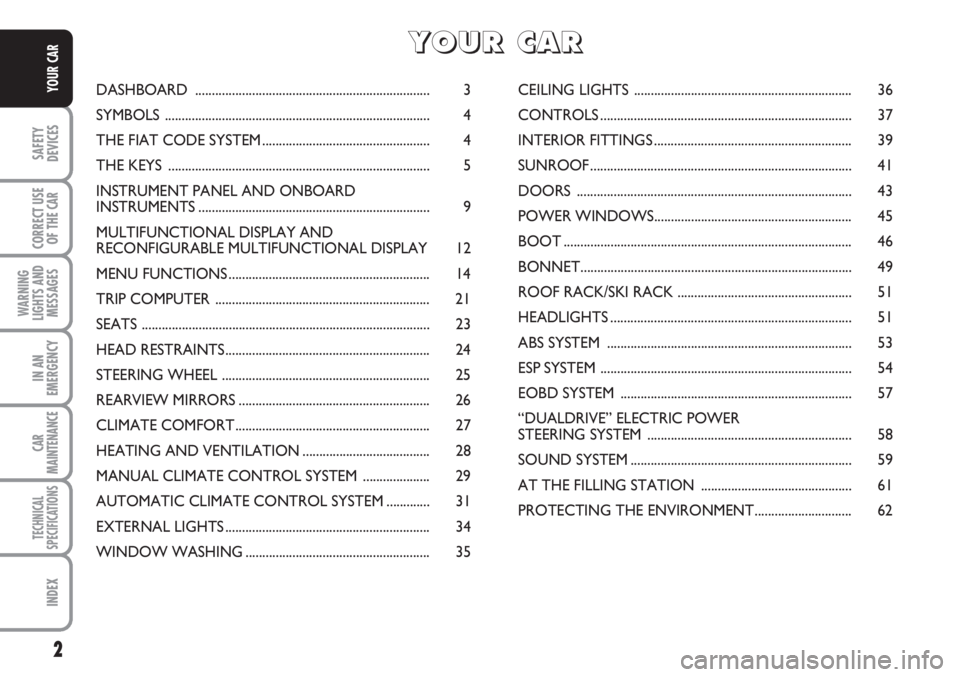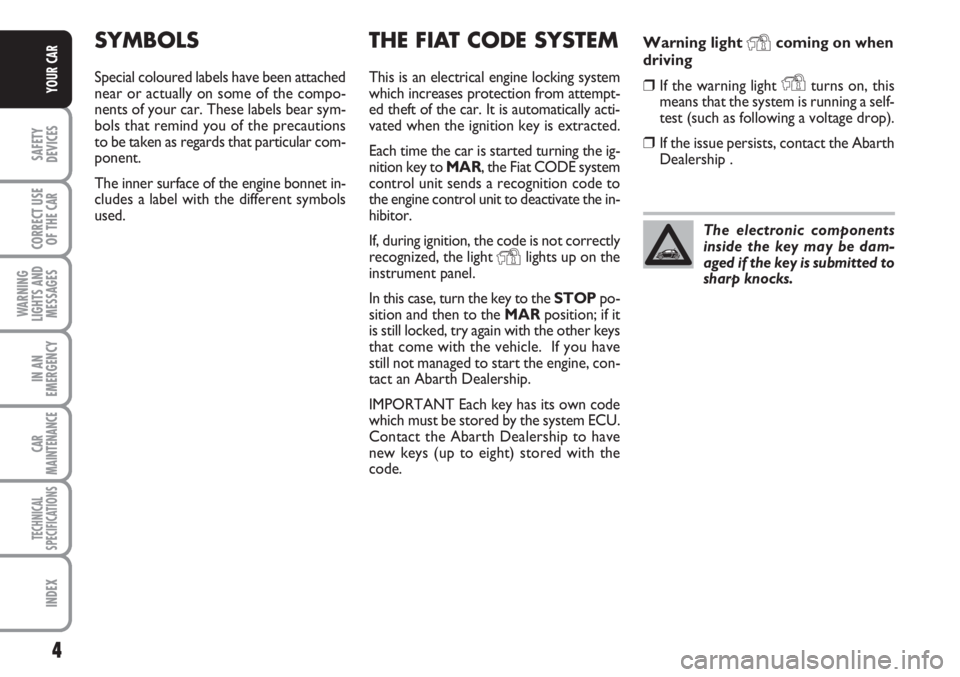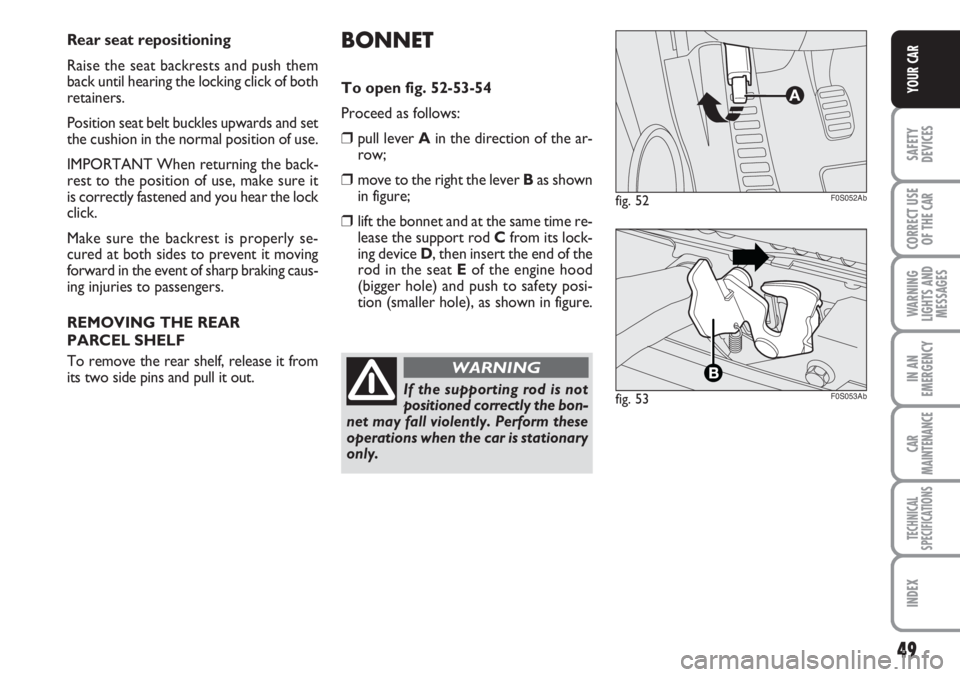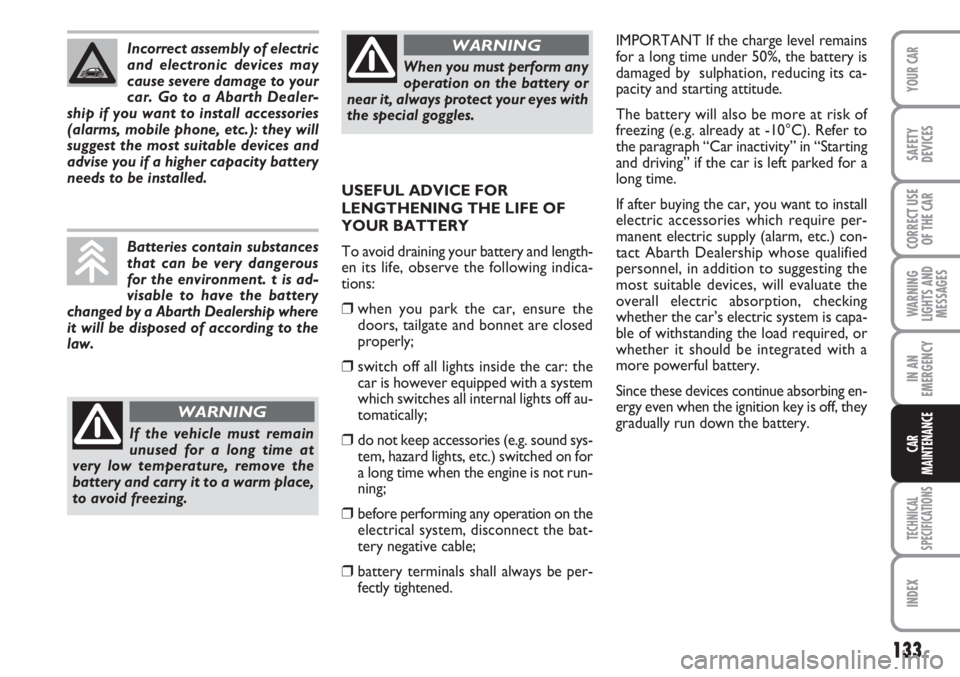bonnet Abarth 500 2011 Owner handbook (in English)
[x] Cancel search | Manufacturer: ABARTH, Model Year: 2011, Model line: 500, Model: Abarth 500 2011Pages: 170, PDF Size: 3.5 MB
Page 3 of 170

2
SAFETY
DEVICES
CORRECT USE
OF THE
CAR
WARNING
LIGHTS AND
MESSAGES
IN AN
EMERGENCY
CAR
MAINTENANCE
TECHNICAL
SPECIFICATIONS
INDEX
YOUR CARDASHBOARD ...................................................................... 3
SYMBOLS ............................................................................... 4
THE FIAT CODE SYSTEM.................................................. 4
THE KEYS .............................................................................. 5
INSTRUMENT PANEL AND ONBOARD
INSTRUMENTS..................................................................... 9
MULTIFUNCTIONAL DISPLAY AND
RECONFIGURABLE MULTIFUNCTIONAL DISPLAY 12
MENU FUNCTIONS............................................................ 14
TRIP COMPUTER ................................................................ 21
SEATS ...................................................................................... 23
HEAD RESTRAINTS............................................................. 24
STEERING WHEEL .............................................................. 25
REARVIEW MIRRORS......................................................... 26
CLIMATE COMFORT.......................................................... 27
HEATING AND VENTILATION ...................................... 28
MANUAL CLIMATE CONTROL SYSTEM .................... 29
AUTOMATIC CLIMATE CONTROL SYSTEM ............. 31
EXTERNAL LIGHTS............................................................. 34
WINDOW WASHING....................................................... 35CEILING LIGHTS ................................................................. 36
CONTROLS........................................................................... 37
INTERIOR FITTINGS........................................................... 39
SUNROOF.............................................................................. 41
DOORS .................................................................................. 43
POWER WINDOWS........................................................... 45
BOOT ...................................................................................... 46
BONNET................................................................................. 49
ROOF RACK/SKI RACK .................................................... 51
HEADLIGHTS........................................................................ 51
ABS SYSTEM ......................................................................... 53
ESP SYSTEM ........................................................................... 54
EOBD SYSTEM ..................................................................... 57
“DUALDRIVE” ELECTRIC POWER
STEERING SYSTEM ............................................................. 58
SOUND SYSTEM.................................................................. 59
AT THE FILLING STATION ............................................. 61
PROTECTING THE ENVIRONMENT............................. 62
Y Y
O O
U U
R R
C C
A A
R R
Page 5 of 170

4
SAFETY
DEVICES
CORRECT USE
OF THE
CAR
WARNING
LIGHTS AND
MESSAGES
IN AN
EMERGENCY
CAR
MAINTENANCE
TECHNICAL
SPECIFICATIONS
INDEX
YOUR CAR
Warning light Ycoming on when
driving
❒If the warning light Yturns on, this
means that the system is running a self-
test (such as following a voltage drop).
❒If the issue persists, contact the Abarth
Dealership .
SYMBOLS
Special coloured labels have been attached
near or actually on some of the compo-
nents of your car. These labels bear sym-
bols that remind you of the precautions
to be taken as regards that particular com-
ponent.
The inner surface of the engine bonnet in-
cludes a label with the different symbols
used.
THE FIAT CODE SYSTEM
This is an electrical engine locking system
which increases protection from attempt-
ed theft of the car. It is automatically acti-
vated when the ignition key is extracted.
Each time the car is started turning the ig-
nition key to MAR, the Fiat CODE system
control unit sends a recognition code to
the engine control unit to deactivate the in-
hibitor.
If, during ignition, the code is not correctly
recognized, the light
Ylights up on the
instrument panel.
In this case, turn the key to the STOPpo-
sition and then to the MARposition; if it
is still locked, try again with the other keys
that come with the vehicle. If you have
still not managed to start the engine, con-
tact an Abarth Dealership.
IMPORTANT Each key has its own code
which must be stored by the system ECU.
Contact the Abarth Dealership to have
new keys (up to eight) stored with the
code.The electronic components
inside the key may be dam-
aged if the key is submitted to
sharp knocks.
Page 50 of 170

49
SAFETY
DEVICES
CORRECT USE
OF THE
CAR
WARNING
LIGHTS AND
MESSAGES
IN AN
EMERGENCY
CAR
MAINTENANCE
TECHNICAL
SPECIFICATIONS
INDEX
YOUR CAR
BONNET
To open fig. 52-53-54
Proceed as follows:
❒pull lever Ain the direction of the ar-
row;
❒move to the right the lever Bas shown
in figure;
❒lift the bonnet and at the same time re-
lease the support rod Cfrom its lock-
ing device D, then insert the end of the
rod in the seat Eof the engine hood
(bigger hole) and push to safety posi-
tion (smaller hole), as shown in figure. Rear seat repositioning
Raise the seat backrests and push them
back until hearing the locking click of both
retainers.
Position seat belt buckles upwards and set
the cushion in the normal position of use.
IMPORTANT When returning the back-
rest to the position of use, make sure it
is correctly fastened and you hear the lock
click.
Make sure the backrest is properly se-
cured at both sides to prevent it moving
forward in the event of sharp braking caus-
ing injuries to passengers.
REMOVING THE REAR
PARCEL SHELF
To remove the rear shelf, release it from
its two side pins and pull it out.
fig. 52
A
F0S052Ab
If the supporting rod is not
positioned correctly the bon-
net may fall violently. Perform these
operations when the car is stationary
only.
WARNING
fig. 53F0S053Ab
Page 51 of 170

50
SAFETY
DEVICES
CORRECT USE
OF THE
CAR
WARNING
LIGHTS AND
MESSAGES
IN AN
EMERGENCY
CAR
MAINTENANCE
TECHNICAL
SPECIFICATIONS
INDEX
YOUR CAR
Before lifting the bonnet, en-
sure that the wiper arm is
not lifted from the windscreen.
WARNING
fig. 54
C
D
E
F0S054Ab
To close fig. 54
Proceed as follows:
❒hold the bonnet up with one hand and
with the other remove rod Cfrom seat
Eand fit it back into its catch D;
❒lower the bonnet to approximately 20
centimetres from the engine compart-
ment and let it drop. Make sure that the
bonnet is completely closed and not on-
ly fastened by the safety catch by trying
to open it. If it is not perfectly closed,
open the bonnet and repeat the proce-
dure. Do not simply press it.
The bonnet must always be
perfectly closed while trav-
elling for safety reasons. Make sure
that the bonnet is perfectly closed
and that the lock is engaged. If you
discover that the bonnet is not per-
fectly closed while travelling, stop im-
mediately and close the bonnet in the
correct manner.
WARNING
With hot engine, operate
with caution inside the en-
gine compartment to avoid burns.
Keep your hands away from the fan:
it may turn on even with key removed
from the switch. Wait for engine cool-
ing.
WARNING
Pay attention to scarves, ties
and other loose fitting gar-
ments. If they accidentally touch
moving parts, they may get dragged
with serious risks for those who wear
them.
WARNING
Page 126 of 170

125
WARNING
LIGHTS AND
MESSAGES
TECHNICAL
SPECIFICATIONS
INDEX
YOUR CAR
SAFETY
DEVICES
CORRECT USE
OF THE CAR
IN AN
EMERGENCY
CAR
MAINTENANCE
SERVICE SCHEDULE
Service coupons shall be performed every 30,000 km
Thousands of kilometres
Check tyre conditions/wear and adjust pressure
if required
Check light system operation (headlights, direction indicators,
hazard lights, passenger compartment lights, boot lights,
instrument panel warning lights, etc.)
Check the operation of the windscreen wiper/washer system,
adjust the sprayers
Check the position and wear of the windscreen and
rear window wiper blades
Check front disc brake pad condition and wear and
operation of pad wear signalling
visually inspect the conditions of: bodywork, underbody
protection, pipes and hoses
(exhaust - fuel - brakes), rubber parts
(boots, sleeves, bushes, etc.)
Check cleanness of locks, bonnet and boot and lever
cleanness and lubrication
Check tension and if necessary adjust the accessory
drive belts
Visually inspect the accessory drive belt conditions
Replace accessory drive belts
Check and adjust handbrake lever stroke30 60 90 120 150 180
●●●●● ●
●●●●● ●
●●●●● ●
●●●●● ●
●●●●● ●
●●●●● ●
●●●●● ●
●●
●●
●
●●●●● ●
Page 128 of 170

127
WARNING
LIGHTS AND
MESSAGES
TECHNICAL
SPECIFICATIONS
INDEX
YOUR CAR
SAFETY
DEVICES
CORRECT USE
OF THE CAR
IN AN
EMERGENCY
CAR
MAINTENANCE
DEMANDING
USE OF THE CAR
Should prevailing use of the car be under
one of the following specially heavy con-
ditions:
❒dusty roads;
❒short distances (less than 7-8 km) re-
peated and with external tempera-
tures below zero;
❒frequently idling engines or long dis-
tance low speed driving or in case of
a long term inactivity;
❒in cities;
perform the following inspections more
frequently than shown on the Service
Schedule:
❒check front/rear disc brake pad con-
dition and wear;
❒check cleanness of bonnet and boot
locks and lever cleanness and lubrica-
tion;
❒visually inspect the conditions of: en-
gine, gearbox, transmission, pipes and
hoses (exhaust - fuel - brakes), rubber
parts (boots, sleeves, bushes, etc.);
❒inspect the battery charge and fluid
level (electrolyte) (refer to the para-
graph “Battery - Inspection of the bat-
tery charge and of the electrolyte lev-
el” in this chapter);
❒visual check on various drive belt con-
ditions;
❒check and if necessary replace the
pollen filter; in particular it shall be re-
placed if a decrease in the air flow in-
to the passenger comportment is de-
tected;
❒check air cleaner and replace, if re-
quired.
REGULAR
INSPECTIONS
Every 1,000 km or before long journeys,
check and top up if required:
❒engine coolant fluid level;
❒brake fluid level;
❒windscreen washer fluid level;
❒tyre pressure and conditions;
❒operation of lights (headlights, direc-
tion indicators, hazard lights, etc.);
❒operation of the windscreen wiper/
washer system, position and wear of
the windscreen and rear window
wiper blades;
Every 3,000 km check the following and
top-up, if required: engine oil level.
You are recommended to use PETRONAS
LUBRICANTSproducts, designed and
produced specifically for Abarth cars (see
table “Capacities” in section “Technical
specifications”).
Page 134 of 170

133
WARNING
LIGHTS AND
MESSAGES
TECHNICAL
SPECIFICATIONS
INDEX
YOUR CAR
SAFETY
DEVICES
CORRECT USE
OF THE CAR
IN AN
EMERGENCY
CAR
MAINTENANCE
IMPORTANT If the charge level remains
for a long time under 50%, the battery is
damaged by sulphation, reducing its ca-
pacity and starting attitude.
The battery will also be more at risk of
freezing (e.g. already at -10°C). Refer to
the paragraph “Car inactivity” in “Starting
and driving” if the car is left parked for a
long time.
If after buying the car, you want to install
electric accessories which require per-
manent electric supply (alarm, etc.) con-
tact Abarth Dealership whose qualified
personnel, in addition to suggesting the
most suitable devices, will evaluate the
overall electric absorption, checking
whether the car’s electric system is capa-
ble of withstanding the load required, or
whether it should be integrated with a
more powerful battery.
Since these devices continue absorbing en-
ergy even when the ignition key is off, they
gradually run down the battery. USEFUL ADVICE FOR
LENGTHENING THE LIFE OF
YOUR BATTERY
To avoid draining your battery and length-
en its life, observe the following indica-
tions:
❒when you park the car, ensure the
doors, tailgate and bonnet are closed
properly;
❒switch off all lights inside the car: the
car is however equipped with a system
which switches all internal lights off au-
tomatically;
❒do not keep accessories (e.g. sound sys-
tem, hazard lights, etc.) switched on for
a long time when the engine is not run-
ning;
❒before performing any operation on the
electrical system, disconnect the bat-
tery negative cable;
❒battery terminals shall always be per-
fectly tightened. Incorrect assembly of electric
and electronic devices may
cause severe damage to your
car. Go to a Abarth Dealer-
ship if you want to install accessories
(alarms, mobile phone, etc.): they will
suggest the most suitable devices and
advise you if a higher capacity battery
needs to be installed.
Batteries contain substances
that can be very dangerous
for the environment. t is ad-
visable to have the battery
changed by a Abarth Dealership where
it will be disposed of according to the
law.
If the vehicle must remain
unused for a long time at
very low temperature, remove the
battery and carry it to a warm place,
to avoid freezing.
WARNING
When you must perform any
operation on the battery or
near it, always protect your eyes with
the special goggles.
WARNING
Page 139 of 170

138
WARNING
LIGHTS AND
MESSAGES
TECHNICAL
SPECIFICATIONS
INDEX
YOUR CAR
SAFETY
DEVICES
CORRECT USE
OF THE CAR
IN AN
EMERGENCY
CAR
MAINTENANCE
❒spraying of plastic parts, with a protec-
tive function, in the more exposed
points: underdoor, inner fender parts,
edges, etc.
❒use of “open” boxed sections to pre-
vent condensation and pockets of mois-
ture from triggering rust inside.
BODY AND UNDERBODY
WARRANTY
Your car is covered by warranty against
perforation due to rust of any original el-
ement of the structure or body.
For the general terms of this warranty, re-
fer to Warranty Booklet.
ADVICE FOR PRESERVING
THE BODYWORK
Paint
Paintwork does not only serve an aes-
thetic purpose, but also protects the un-
derlying sheet metal.
Touch up abrasions and scratches immedi-
ately to prevent the formation of rust. On-
ly use genuine spare paint products for
touch-ups (see “Bodywork paint identifi-
cation plate” in the “Technical Specifica-
tions” section).Normal maintenance of paintwork consists
in washing the car: the frequency depends
on the conditions and environment where
the car is used. For example, it is advisable
to wash the car more often in areas with
a high environmental pollution or on roads
sprinkled with salt.
To correctly wash the car:
❒remove the aerial from the roof to pre-
vent damage to it if the car is washed in
an automatic system;
❒if high pressure water jets are used to
wash the car, make sure they are at
least 40 cm away from the bodywork
to avoid causing damage. It should be
remembered that a build up of water
could cause damage, in the long term,
to the car;
❒wash the body using a low pressure jet
of water;
❒wipe a sponge with a slightly soapy so-
lution over the bodywork, frequently
rinsing with the sponge;
❒rinse well with water and dry with a jet
of air or a chamois leather.
Dry the parts less in sight particularly care-
fully, such as the door frames and the
headlight frames, where water may stag-
nate more easily. It is a good idea to leave
the car in the open for a while after wash-
ing it to give time for the water to evap-
orate.Do not wash the car after it has been
parked in the sun or when the engine is
bonnet is hot: this could take the shine off
the paint.
Exterior plastic parts must be cleaned in
the same way as the rest of the car.
Where possible, do not park under trees;
the resinous substance many species re-
lease give the paint a dull appearance and
increase the possibility of triggering rust
processes.
IMPORTANT Bird droppings must be
washed off immediately and thoroughly as
the acid they contain is particularly ag-
gressive.
Detergents cause water pollu-
tion. The car should be washed
in areas equipped for collect-
ing and purifying the liquid
used in the washing process.
Page 161 of 170

160
WARNING
LIGHTS AND
MESSAGES
YOUR CAR
SAFETY
DEVICES
CORRECT USE
OF THE
CAR
IN AN
EMERGENCY
CAR
MAINTENANCE
TECHNICAL
INDEX
Boot light .............................................. 46
– bulb replacement .......................... 115
Boot ........................................................ 46
– opening ........................................... 46
– closing ............................................. 47
– extension ........................................ 48
Brake fluid level ................................... 131
Brakes..................................................... 147
– specifications ................................. 147
– brake fluid level ............................. 131
Capacities ............................................ 154
Car maintenance and care ................ 123
– scheduled servicing ...................... 127
– service schedule ........................... 124
– scheduled maintenance plan ...... 125
– heavy-duty use of the car ........... 127
Carrying children in safety ................ 67
Ceiling light .......................................... 36
– activation ........................................ 36
– bulb replacement .......................... 114
Ceiling light .......................................... 36
– front ................................................ 36
– boot compartment ....................... 46
Central storage compartment .........40
Chassis marking ................................ 143
Checking fluid levels ........................... 128Child seats
(compliance for use) .................. 70-72
Cigar lighter ......................................... 39
Climatic comfort ................................ 27
– ventilation ...................................... 27
Clutch ................................................... 146
CO
2emissions .................................... 158
Code card ............................................ 5
Consumptions ..................................... 157
– fuel ................................................... 157
– motor oil ........................................ 139
Controls ............................................... 37
Cup holders ......................................... 40
Current outlet ..................................... 41
Dashboard .......................................... 3
Daytime lights ....................................... 34
– activation......................................... 34
– bulb replacement ........................... 113
Dimensions .......................................... 151
Dipped beam headlights .................... 34
– activation ........................................ 34
– bulb replacement .......................... 112
Direction indicators ........................... 34
– activation ........................................ 34
– front bulb replacement ............... 111
– side bulb replacement ................. 112
ABS System ........................................ 53
Accessories purchased by
the owner .......................................... 60
Air filter ................................................ 132
Air recycle ..................................28-29-31
Air vents ............................................... 27
Airbag .................................................... 73
– driver's front airbag....................... 74
– front airbag passenger side .......... 74
– driver's knee-level airbag ............. 75
– Side bag-Window bag ............ 75-76
ASR ......................................................... 56
Automatic climate control system 31
Battery.................................................. 132
– jump starting with battery .......... 96
– useful advice .................................. 133
– inspecting the charge ................ 132
– battery charger ............................. 121
– replacement ................................... 132
Bodywork .............................................. 137
– version codes ................................ 144
– warranty ......................................... 138
– maintenance .................................. 138
– protection ...................................... 137
Bonnet .................................................. 49
Boot extension .................................... 48
I I
N N
D D
E E
X X